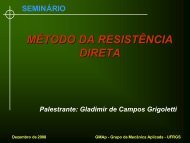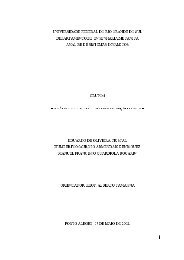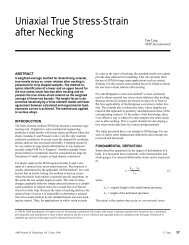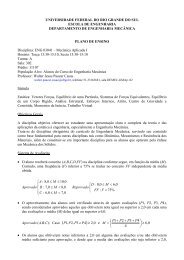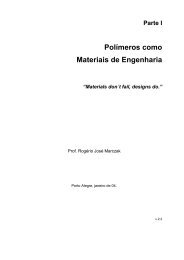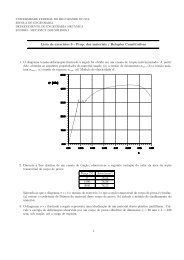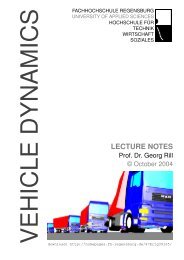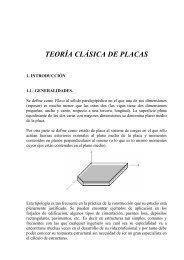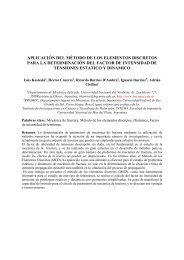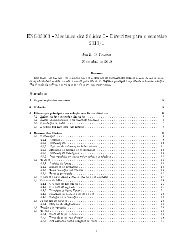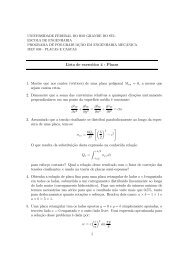Environmental Impact from Blasting - GMAp
Environmental Impact from Blasting - GMAp
Environmental Impact from Blasting - GMAp
- No tags were found...
Create successful ePaper yourself
Turn your PDF publications into a flip-book with our unique Google optimized e-Paper software.
<strong>Environmental</strong> <strong>Impact</strong> <strong>from</strong> <strong>Blasting</strong>Ground VibrationAir BlastNoiseFly RockDust and fume
Vibration and airblastNoise <strong>from</strong> mining is a common source ofcommunity concern because operational noiseemissions frequently occur on a continuous basis.This can interfere unreasonably with day to dayactivities, particularly concentration, recreation andsleep, and result in an adverse impact on residentialamenity.Vibration and airblast <strong>from</strong> blasting can lead tocommunity concern primarily due to the fear ofstructural damage.This fear occurs because people are able to detectvibration at levels which are well below those whichresult in even superficial (apparent rather thanactual) damage to buildings and items of heritagevalue.
Effect of Ground Vibration to human being0.1 mm/sec - not noticeable0.15 mm/sec - nearly not noticeable0.35 mm/sec - seldom noticeable1.00 mm/sec - always noticeable2.00 mm/sec - clearly noticeable6.00 mm/sec - strongly noticeable14.00 mm/sec - very strongly noticeable17.8 mm/sec - severe noticeable
Expected DamagePPV (mm/s)13 Lower limit for damage to plaster walls19 Lower limit for dry wall structures70 Minor damage140 >50% change of minor damage to structures190 50% chance of major damage
Recommended Maximum Peak Particle Velocities by AustralianStandards Explosives Code (AS 2187.2 - 1993)Housing and low rise residential buildings, Commercial buildingsnot included below10 mm/sCommercial and industrial buildings or structures of reinforcedconcrete or steel constructions25 mm/sFor high rise, hospitals, long floor spans, dams or historicbuildings where no specified limit exists5mm/s
The criteria normally recommended for blasting inAustralia, based on human comfort, are contained in theAustralian and New Zealand Environment Council(ANZEC) guidelines. The ANZECcriteria for the control ofblasting impact at residences are:The recommended maximum level for ground vibration is 5mm/s (peak particle velocity [ppv]).The ppv level of 5 mm/s may be exceeded on up to 5% of thetotal number of blasts over a period of 12 months. The levelshould not exceed 10 mm/s at any time.<strong>Blasting</strong> should generally only be permitted during thehours of 0900 hrs to 1700 hrs Monday to Saturday. <strong>Blasting</strong>should not take place on Sundays and public holidays.
British Standard 7385:Part 2-1993Reinforced or framed structures Industrial and heavycommercial buildings at 4 Hz and above50 mm/sUn-reinforced or light framed structures Residential or lightcommercial type buildings at 4 Hz –15 Hz15-20 mm/sUn-reinforced or light framed structures Residential or lightcommercial type buildings at 15 Hz –40 Hz and above20-50 mm/s
German DIN 4150 Standard for ground vibrationcaused by blastingStructure typePPV Guide value (mm/s)Frequency
Combined Ground Vibration Measurement of all Site
V = K (R/(Q) .50 ) BWhereV = Peak particle velocity (mm/s)K = Site and rock factor constantQ = Maximum instantaneous charge per delay (kg)B = Constant related to the rock and site(usually -1.6)R = Distance <strong>from</strong> charge (m)(R/(Q) .50 is defined as a scaled distance
Typical K Factors – Metric System(Under confined) - hard or highly structured rock = 500Free face average rock (Normal confinement) = 1,140Heavily (Over)confined = 5,000Typical K Factors – English system(Under confined) - hard or highly structured rock = 24Free face average rock (Normal confinement) = 160Heavily (Over) confined = 600
The USOSM regulationsMethod 1: Limiting Particle Velocity CriterionMethod 2: Scaled Distance Equation CriterionMethod 3: Blast Level Chart Criterion
Method 1: Limiting Particle Velocity CriterionDISTANCE FROMBLAST SITE (ft.)0 – 300301-5,000>5,000MAXIMUMALLOWABLE PEAKPARTICLEVELOCITY (in./sec.)1.251.00.75
Method 2: Scaled Distance Equation CriterionDISTANCE FROMBLAST SITE (ft.)0 – 300301-5,000>5,000SCALED DISTANCEFACTORS TO BEUSED WITHOUTSEISMICMONITORING(FT/(lb) 0.5 )505565
Method 3: Blast Level Chart Criterion allows anoperators to use peak particle velocity limits that vary with frequencyUSOSM Regulation using method 3
Ground Vibration and Air blast Monitoring
Ground Vibration and Air blast Record
1 10 100 10001,000100PPV(mm/s)101y = 41.586x -1.3751R 2 = 0.64150[(D/(W)^0,5) :(m/(kg)^0,5)]Combined Ground Vibration Measurement (Thailand)
How to control Ground Vibration-Minimize charge per delay of Explosive-Exercise strict control over spacing andorienting all blast drill holes-Optimize the amount of explosives inblasting-Minimize degree of confinement byincreasing free face and Using the minimumpracticable sub-drilling
How to control Ground Vibration- Increase distance <strong>from</strong> reception area- Make sure the order of firing is correct- Minimize frequency of blast-Interrupt the continuity of rock mass- Use smaller diameter of blast hole-Investigate alternative rock-breakingtechniques
Control of Ground Vibration at sourcesControl Maximum charge per delay32 meter per square root of kilogram explosive tocontrol PPV for not more than 10.0 mm/sec55 meter per square root of kilogram explosive tocontrol PPV for not more than 2.0 mm/sec
<strong>Environmental</strong> <strong>Impact</strong> <strong>from</strong> <strong>Blasting</strong>Noise and Air Blast-Noise (Sound) 20-20000 Hz- Air Blast Less than 20 Hz
Examples illustrating the decibel(A) scale20 - Quite countryside40 - Living room60 - Conversational speech80 - Busy road, loudly conversation90 - Haul truck @ 7 m100 - Pneumatic hammer,rock breaker @ 7 m110 - Rock band, production blast @ 100m120 - Threshold of discomfort140 - Threshold of pain, jet plane@ 100m
Combined Airblast Measurements
P = K (R/(Q) .33 ) BWhereP = Pressure (kPa)K = State of confinementQ = Maximum instantaneous charge per delay (kg)R = Distance <strong>from</strong> charge (m)(R/(Q) .33 is defined as a scaled distance
B = Constant related to the rock and site (usually = -1.2)Typical K FactorsUnconfined 185Fully confined 3.3Recommended Levels for Airblast Sound levels (AS2187.2 - 1993)Human discomfort 120 dBStructure damage or historical buildings where nospecified limit exists 133 dB
Noise and Air Blast StandardNoise Standard (Thai)< 125 dB(A) at reception pointThe US Office of Surface Mining has presented thefollowing regulatory limits for airblast <strong>from</strong>blasting (depending on the low frequency limit ofthe measuring system):
The criteria normally recommended for blasting in Australia,based on human comfort, are contained in the Australian andNew Zealand Environment Council (ANZEC) guidelines. TheANZECcriteria for the control of blasting impact at residencesare:The recommended maximum level for airblast is 115 dBLinear.The level of 115 dBLinear may be exceeded on up to 5% of thetotal number of blasts over a period of 12 months however, thelevel should not exceed 120 dBLinear at any time.<strong>Blasting</strong> should generally only be permitted during the hours of0900 hrs to 1700 hrs Monday to Saturday. <strong>Blasting</strong> should nottake place on Sundays and public holidays.
How to control Noise and AirBlast-Minimize charge per delay of Explosive-Use a hole spacing and burden which will ensure that theexplosive force is just sufficient to break the ore to therequired size.(Recheck Explosive factor)-Eliminate exposed detonating cord and secondaryblasting. In the event that an explosive detonating cord isused to detonate the blast holes, it should be covered witha suitable aggregate material.-However, the potential for initiation-related airblastemissions can be minimized with the use of NONEL (nonelectric) initiation systems.
How to control Noise and Air Blast- Orient quarry faces away <strong>from</strong> potentially sensitivereceivers.-Ensure stemming depth and type is adequate- Restrict blasts to favorable weather conditions. Whereverpossible blasting should be confined to between 0900hours to 1700 hours to minimize the noise-enhancingeffects of temperature inversions-Avoid shallow blasting or secondary blasting-Use barrier between blast area and reception points-Minimize frequency of blast
An aerial view provides a clear perspective on boundingdesigned to limit noise impacts near the KalgoorlieConsolidated Gold Mines in Western Australia
Control of Air Blast at sources (Mining)Control Maximum charge weight per delayTo control Noise dB(A) for not more than 125 dB(A)And to control dB(l) for not more than 133 dB(l)Maximum charge weight per delay should be morethan 76 meter per cube root of kilogram explosivedB(A) ~ dB(l)- (40)
Fly Rock-One of the greatest challenges, which a blaster faces inmining and construction blasting, is to accuratelydetermine the bounds of the blast area-Fatal injuries due to lack of blast area security wereprimarily caused by failure to clear blast area orinadequate access control to the blast area-At a limestone mine, a neighbor walked into the blast areaand was fatally injured. The blaster could not see thevictim entering the blast area <strong>from</strong> the firing station. Inanother case, a passenger in a vehicle was fatally injuredby flyrock because road traffic was not monitored duringthe blast. In another example, a dozer operator entered ablast area due to lack of access control.
<strong>Blasting</strong> ShelterThe blaster was firing charges inside two water well holes. When theshot was fired a piece of flyrock traveled about 208 ft. (63.4 m) andstruck the blaster on the head (he was not wearing a hard hat), fatallyinjuring him. He was standing in the clear, and had no protection<strong>from</strong> flyrock
Fatal injury due to flyrock at a limestone mine
Fly RockThe U.S. Code of Federal Regulations (CFR), Title 30,Part 57.6000, defines ‘Blast Area’ as the area in whichconcussion (shock wave), flying material, or gases<strong>from</strong> an explosion may cause injury to persons.The US Federal Office of Surface Mining (USOSM)regulations [30 CFR § 816.67 and 817.67] help tocharacterize the bounds of the blast area by specifyingthat flyrock shall not be cast <strong>from</strong> the blasting site.
Institute of Makers of Explosives (IME) hasdefined flyrock as the rock(s) propelled <strong>from</strong> the blastarea by the force of an explosion [IME1997]. Aflyrock related injury is sustained when a blastpropels rock beyond the blast area and it injuressomeone. The primary factors for flyrock are:• insufficient burden,• improper blast-hole layout, loading, (excessive)powder factor• anomaly in the geology and rock structure,• insufficient stemming, and• inadequate delay time (hole to hole or row to row).
An injury due to lack of blast area security occurs when anunauthorized person is in the blast area when the shot isdetonated or when a person fails to use an adequate blastingshelter. The main causes for injuries due to lack of blast areasecurity were:• failure to evacuate the blast area by employees andvisitors,• failure to understand the instructions of the blaster orsupervisor,• inadequate guarding of the access roads leading to theblast area,• taking shelter at an unsafe location, and• failure to use a blasting shelter.
Fly Rock- The following factors shall be considered to determinethe blast area:- Geology or material to be blasted- Blast pattern :Burden, depth, diameter, and angle of theholes-<strong>Blasting</strong> experience of the mine- Delay systems, powder factor, and pounds per delay-Type and amount of explosive material-Type and amount of stemming
Fly Rock- MSHA accident data reveal that most blasting accidentsin surface and underground mines occur during scheduledblasting and are due to inadequate blast area security:- The functional task-elements of a blast area securitysystem are-Estimate the flyrock zone based on shot conditions, andadd a factor of safety to determine the bounds of the blastarea.-Clear all employees, contractors, and visitors <strong>from</strong> theblast area.
Fly Rock-Post guards at the access points to prevent unauthorizedentry-Use adequate blasting shelters for employees whosepresence is required in the blast area-Maintain effective communication with guards, mineforeman, and other employees.
The major causes of blasting-related injuries insurface mines are lack of blast area security, flyrock,premature blast, misfire, and disposal.Inadequate size of the blast area, flyrock, and lack ofblast area security (including lack of blasting shelter)accounted for 68% of the injuries.
How to control Fly Rock- Orient quarry faces away <strong>from</strong> potentially sensitivereceivers. (Select the direction of blasting face so as toplace any person or buildings at the rear of the face)-Ensure stemming depth and type is adequate- Choose a burden of sufficient magnitude to reduce thepossibility of blast through- Take special care when carrying out secondary blastingto avoid overcharging-Avoid shallow blasting that is generally less than 1 meter- Cover the rock to be blasted with suitable material, to
How to control Fly Rock- Make sure that the order of firing is correct-Cover the rock to be blasted with suitable material, tocontrol fly-rock, if necessary.-Make sure that the blast area security is adequate
Identify of <strong>Blasting</strong> AreaBLASTING AREA! KEEP OFFWARNING!BLASTING AREA
Explosive and <strong>Blasting</strong> SafetyUse electric caps made by the same manufacturers in the samecircuitAlways keep the electric cap wires as short-circuitedBe sure that all wire ends are clean before connectingRecognize the possibility of static electrical hazards andstray currentDo not fight fires in explosive materialsDo not handle explosives during an electrical stormDo not expose explosive materials to impact,excessive heat<strong>from</strong> flame-producing devices, friction, or electrical impulses
Explosive and <strong>Blasting</strong> SafetyTransport, store, handle and use explosive with careCheck every cap before usingUse only blasting machine designed for firing the blastUse only device designed for checking capMake sure the order of firing is correctDo not try to fire the blast when the current is not enoughFollow federal, state, local and safety laws and regulationsDo not fire a blast without a positive signalMake sure all persons and equipment are safe before firingDo not attempt to investigate a misfire too soon



